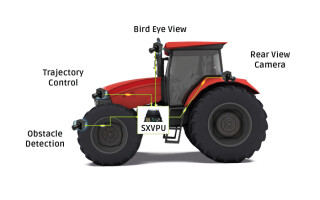Advantages of Zonal Architecture in Embedded Imaging Systems
February 21, 2025
Blog

When you’re developing an embedded imaging system, availability is usually not much of an issue if off-the-shelf components work for you. But while the built-in processing of today’s smart cameras can produce good results, functional safety requirements may necessitate access to image data on a deeper level than provided by such black-box solutions.
One of the challenges facing mid-sized projects with more particular requirements is that AI-capable chipsets are either not available to manufacturers handling limited numbers of units – major chip manufacturers won’t bother with you if you’re only going to build 1000 systems! – or if they are available, the high cost per unit makes their use a non-starter in a commercial project.
Utilizing zonal architecture in your system design can be an easy way to side-step these issues. First, by bundling data from multiple cameras in a single processing unit, the number of required AI-capable chipsets – and thus the cost – can be kept to a fraction to that of a standard system setup using smart cameras with individual processing.
Transmission of image data for processing over larger distances poses its own set of challenges. With more demanding imaging applications, image quality is crucial. But compressed video streams often sacrifice the decisive fine detail that a neural network would need for reliable object recognition or other image analysis tasks. Uncompressed video, however, requires a lot of bandwidth, which is a problem when the central image processing unit is far removed from the cameras feeding it video data. Typical automotive interfaces like FPD-Link or GMSL don’t support cable lengths over more than 15 meters.
Zonal architecture provides a clever solution by handling image processing within a zone close to the sensors. This way, uncompressed image data straight from multiple sensors can be used for the AI processing before the image data is subjected to video compression. A common technology like Ethernet can then be used to transmit the compressed video stream – along with the results of the AI image analysis – to a central control unit without sacrificing important information.
Solectrix has been working with several customers in the agricultural, industrial, and construction vehicle market to develop a solution that can process image data from up to four cameras in a single processing unit.SXVPU, short for Smart eXtensible Vision Processing Unit, is an AI-powered image processing box designed around AMD technology, and its H.264/H.265 codec supports low-latency 4K video streaming via Ethernet, enough to include 1080p video from four cameras at once.





